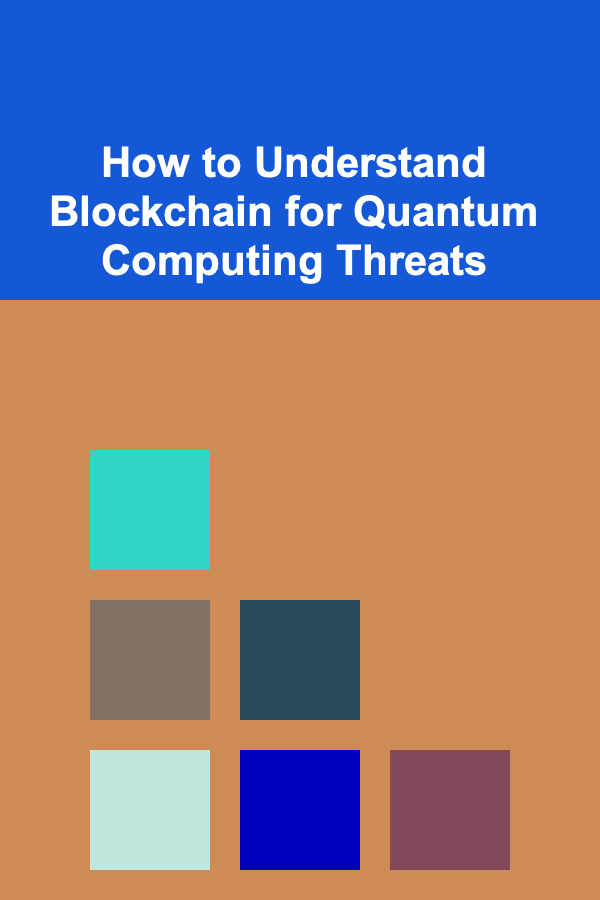
How to Understand Blockchain for Quantum Computing Threats
ebook include PDF & Audio bundle (Micro Guide)
$12.99$5.99
Limited Time Offer! Order within the next:

The intersection of blockchain technology and quantum computing is becoming an increasingly critical topic of discussion within both technological and security circles. Blockchain, often associated with cryptocurrencies like Bitcoin, is a decentralized ledger system that promises to revolutionize data integrity, transparency, and security. On the other hand, quantum computing, a powerful new computational paradigm, has the potential to dramatically alter the landscape of encryption and cryptography as we know it.
At the heart of these two fields lies a major concern: Quantum computers could pose a significant threat to the security mechanisms that underpin blockchain technology. Cryptographic algorithms, which secure blockchain transactions, rely on mathematical problems that are currently difficult for classical computers to solve but may be easily broken by quantum algorithms. This article explores how quantum computing poses a threat to blockchain technology, the implications of this threat, and how blockchain systems might evolve to defend against quantum attacks.
The Basics of Blockchain
What is Blockchain?
Blockchain is a distributed ledger technology that enables secure, transparent, and tamper-resistant record-keeping. It is decentralized, meaning that no single entity or authority has control over the entire blockchain. Instead, transactions are verified by a network of participants (nodes), ensuring that data is consistently and accurately maintained. Blockchain consists of "blocks" that contain transaction data, and these blocks are linked (or chained) together in a chronological order.
Key features of blockchain include:
- Decentralization: No central authority controls the blockchain, making it less susceptible to manipulation or failure from a single point of attack.
- Immutability: Once a transaction is recorded on the blockchain, it is very difficult to alter or delete, which makes it a reliable tool for maintaining records.
- Transparency: Blockchain is transparent to all participants, allowing anyone with access to the blockchain to verify transactions.
- Security: Blockchain employs cryptographic algorithms to ensure data integrity and prevent unauthorized access or alteration.
The most well-known application of blockchain is cryptocurrency, especially Bitcoin, which uses blockchain to enable peer-to-peer transactions without the need for intermediaries like banks. However, blockchain technology has expanded beyond cryptocurrencies and is being applied to a wide variety of sectors, including supply chain management, healthcare, and voting systems.
Blockchain and Cryptography
The security of blockchain networks is heavily reliant on cryptography. Blockchain uses cryptographic hash functions, digital signatures, and public-key cryptography to ensure the authenticity and confidentiality of transactions.
- Hash Functions: These are mathematical functions that take an input (or "message") and generate a fixed-length string of characters, which appears random. The key property of a hash function is that even the smallest change in the input will result in a completely different output, making it nearly impossible to predict or reverse-engineer the original input.
- Digital Signatures: Digital signatures ensure that a transaction is authorized by the owner of the private key. A public-private key pair is used to sign and verify transactions, ensuring that only the rightful owner can initiate a transaction.
- Public-Key Cryptography: This system uses two keys: a public key, which can be shared freely, and a private key, which must be kept secret. Public-key cryptography ensures that only the holder of the private key can decrypt messages encrypted with the corresponding public key.
While these cryptographic techniques are currently considered secure, quantum computing threatens to undermine their effectiveness.
Understanding Quantum Computing
What is Quantum Computing?
Quantum computing represents a new paradigm in computation, leveraging the principles of quantum mechanics to perform computations in ways that classical computers cannot. Quantum computers process information using quantum bits, or qubits, which differ fundamentally from classical bits.
In classical computing, bits are either in a state of 0 or 1. In quantum computing, qubits can exist in multiple states simultaneously, thanks to a phenomenon called superposition. Additionally, qubits can be entangled, meaning the state of one qubit can be dependent on the state of another, even over vast distances. These properties allow quantum computers to perform certain calculations much faster than classical computers.
Key features of quantum computing include:
- Superposition: A qubit can be in a state of 0, 1, or both at the same time, allowing quantum computers to explore multiple solutions simultaneously.
- Entanglement: When qubits become entangled, their states are linked, meaning the state of one qubit can directly affect the state of another, even if they are physically separated.
- Quantum Speedup: Quantum computers have the potential to solve certain problems exponentially faster than classical computers, particularly problems related to factoring large numbers, searching large databases, and simulating quantum systems.
While quantum computing holds tremendous potential for scientific advancement, it also introduces significant challenges to existing encryption systems, particularly those that secure digital information.
Quantum Threats to Cryptography
Quantum computing poses a unique threat to traditional cryptographic techniques that secure digital data, including those used in blockchain technology. The primary concern revolves around the potential of quantum computers to break commonly used cryptographic algorithms, such as RSA and elliptic curve cryptography (ECC), which form the backbone of most blockchain systems' security protocols.
- Shor's Algorithm: Shor's algorithm is a quantum algorithm that can efficiently factor large integers and compute discrete logarithms. This would render RSA and ECC algorithms vulnerable, as both rely on the difficulty of factoring large numbers or solving discrete logarithm problems as the foundation of their security. With Shor's algorithm, a sufficiently powerful quantum computer could break the encryption in a matter of seconds.
- Grover's Algorithm: Grover's algorithm provides a quantum speedup for unstructured search problems. While it doesn't break encryption in the same way as Shor's algorithm, it could reduce the effective security of symmetric-key cryptographic algorithms like AES. For example, Grover's algorithm could halve the strength of AES, making it easier to crack with a quantum computer.
The potential for quantum computers to break these encryption systems is a serious concern for blockchain technology, as they would be able to break the cryptographic signatures and the integrity of transactions that form the foundation of blockchain security.
Quantum Computing and Blockchain Security
Blockchain relies heavily on cryptography to secure its transactions and maintain trust within the network. However, quantum computers, by virtue of their ability to break traditional cryptographic systems, pose an existential threat to the security and integrity of blockchain technology.
Quantum Threats to Blockchain Transactions
- Breaking Public-Key Cryptography: As previously mentioned, quantum computers could break the RSA and ECC algorithms used in blockchain transactions. Public-key cryptography is fundamental to the integrity of blockchain, as it is used to generate digital signatures that verify transactions. If a quantum computer could decrypt the private key from a public key, it would be able to forge transactions and impersonate the legitimate owner of a wallet.
- Compromising Transaction History: One of the main features of blockchain is its immutable ledger. Once a transaction is recorded on the blockchain, it is considered tamper-proof. However, if a quantum computer can break the cryptography that secures these transactions, it could potentially alter the blockchain's transaction history, undermining the trust and security of the entire system.
- Breaking Consensus Mechanisms: Blockchain networks rely on consensus mechanisms, such as Proof of Work (PoW) or Proof of Stake (PoS), to validate transactions. While these mechanisms are not directly reliant on encryption, the security of the blockchain as a whole depends on the cryptographic security of the nodes within the network. If quantum computers were able to break the cryptographic algorithms used by nodes, they could compromise the entire consensus process.
The Race for Post-Quantum Cryptography
To defend against quantum computing threats, the cryptographic community has been working on developing post-quantum cryptography (PQC) algorithms that are resistant to attacks from quantum computers. The National Institute of Standards and Technology (NIST) is leading efforts to standardize post-quantum cryptographic algorithms, with several promising candidates emerging in recent years.
Post-quantum cryptography aims to replace vulnerable algorithms like RSA and ECC with algorithms that are resistant to quantum attacks. Some of the leading candidates for post-quantum cryptography include:
- Lattice-Based Cryptography: Lattice-based cryptographic schemes rely on the hardness of problems related to high-dimensional lattices, which are believed to be difficult for quantum computers to solve.
- Code-Based Cryptography: Code-based cryptography is based on the difficulty of decoding random linear codes, which is thought to be resistant to quantum attacks.
- Multivariate Cryptography: This approach relies on the difficulty of solving systems of multivariate polynomial equations over finite fields, which is also believed to be resistant to quantum algorithms.
By implementing these post-quantum cryptographic algorithms, blockchain networks can future-proof themselves against quantum computing threats and continue to provide secure and tamper-resistant ledgers.
Conclusion
Quantum computing represents a monumental shift in the world of technology, with the potential to break the cryptographic systems that currently secure blockchain networks. The fear that quantum computers could undermine the security and integrity of blockchain technology is a serious concern, but it is not insurmountable. As quantum computing technology continues to evolve, so too does the development of quantum-resistant cryptographic techniques.
Blockchain networks are increasingly aware of these risks and are exploring ways to implement post-quantum cryptography to ensure their continued security in a world dominated by quantum computing. While the full impact of quantum computers on blockchain technology remains to be seen, one thing is certain: the race for quantum-safe blockchain systems has already begun. The future of blockchain will depend on the ability of developers, cryptographers, and organizations to adapt and evolve alongside the advances in quantum computing.

How to Cut Your Monthly Rent or Mortgage Payment
Read More
How to Use Color Psychology to Energize Your Workout Space
Read More
How to Design Professional Business Cards: A Comprehensive Guide
Read More
How to Navigate a Job Loss Financially
Read More
How to Meal Plan Around Sales and Seasonal Produce
Read More
How to Master Transportation Management Systems (TMS) as a Logistics Coordinator
Read MoreOther Products

How to Cut Your Monthly Rent or Mortgage Payment
Read More
How to Use Color Psychology to Energize Your Workout Space
Read More
How to Design Professional Business Cards: A Comprehensive Guide
Read More
How to Navigate a Job Loss Financially
Read More
How to Meal Plan Around Sales and Seasonal Produce
Read More